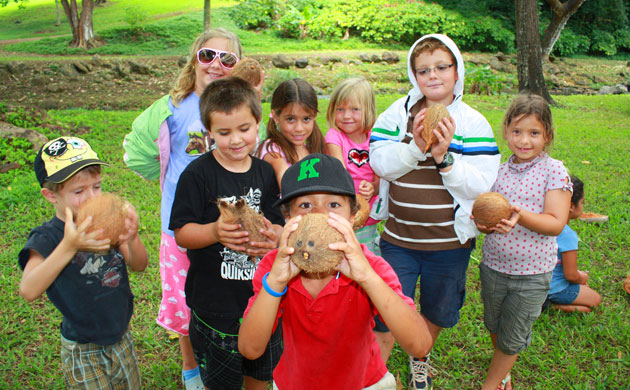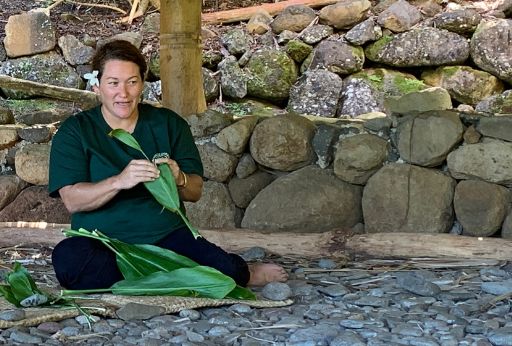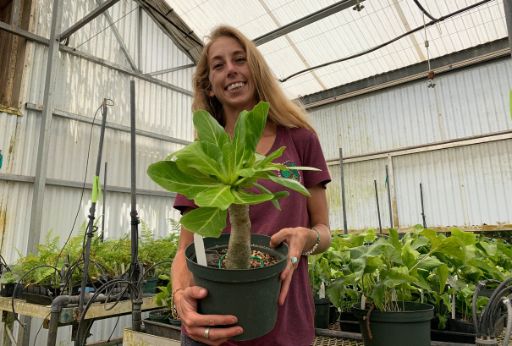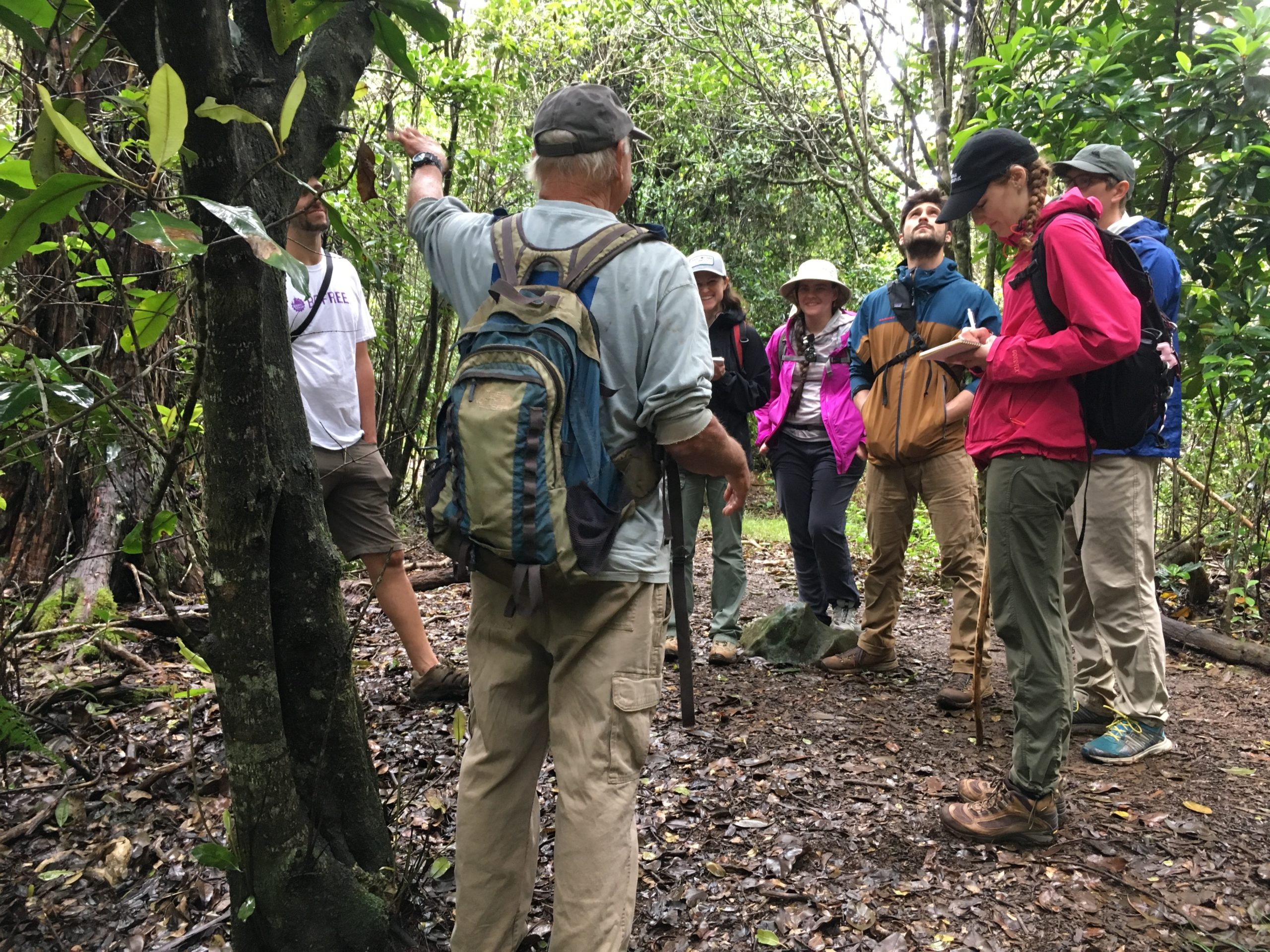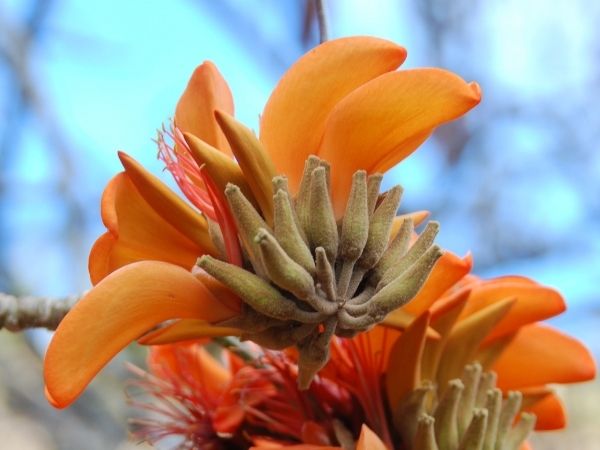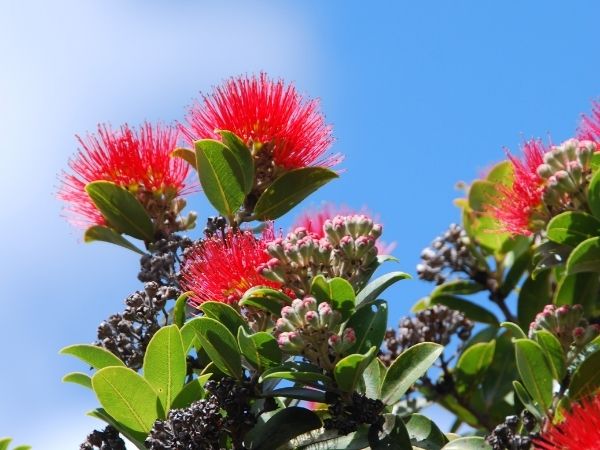Tropical Plant Database - Plant Details
Santalum ellipticum
Click on any heading above to view more information about this plant
Conservation Status
- IUCN: Not Evaluated
- USFWS: None
Family: SANTALACEAE
Genus: Santalum
Species: ellipticum
Species Author: Gaudich.
Vernacular: Hawaiian Sandalwood, Iliahi
Genus: Santalum
Species: ellipticum
Species Author: Gaudich.
Vernacular: Hawaiian Sandalwood, Iliahi
Coastal sandalwood is a bushy shrub or a multi-stemmed small tree reaching about 5 to 10 m in height. Sandalwood trees are root-parasitic, meaning that they have root extensions that capture water and nutrients from certain other plant species, which are called host-species. Santalum ellipticum is an extremely variable species in vegetative and floral characters. The grayish-green leaves are 2.5-6 cm long and 1.7-4 cm wide, elliptic to ovate and leathery to succulent, and generally glaucous(covered with a fine white powder that is easily rubbed off). This species has thicker leaves than other Hawaiian species found at higher elevations, which is an adaptation for water conservation. Inflorescences are compound cymes of flowers that are greenish when they are in bud. After opening the corolla remains greenish but it is tinted with brown, orange or salmon. The flowers lack true petals and are actually modified sepals, and they emanate a sweet fragrance. The spherical fruits are 9 to 12 mm in diameter and have a ring at the top where the flower parts were attached. The mature fruits are purple to black and each contains one seed.
(Wagner, L. W., Herbst D. R. and Sohmer S. H. 1999. Manual of Flowering Plants of Hawai`i)
(Wagner, L. W., Herbst D. R. and Sohmer S. H. 1999. Manual of Flowering Plants of Hawai`i)
In traditional medicine, the Hawaiians used the powdered wood as a remedy for lice infestation. A shampoo made from the leaf infusion was also used for eliminating head lice and to eliminate dandruff.
A drink made from the powdered heartwood mixed with other plants was used in treating affections of male and female sex organs.
(Kraus, B. H. 1993. Plants in Hawaiian Culture)
A drink made from the powdered heartwood mixed with other plants was used in treating affections of male and female sex organs.
(Kraus, B. H. 1993. Plants in Hawaiian Culture)
The Hawaiians used the powdered wood as a perfume to scent tapa cloth and mix with coconut oil to use as body lotion. The wood was also used to make musical instruments such as the musical bow, called ukeke. Wooden tools including the hoe and paddles were crafted from sandalwood. The aromatic oil derived from the wood was also used for medicine.
Today, the fragrant wood is highly valued for carving chests and other decorative furniture, boxes and religious statues.
The oil from the heartwood is used for cosmetics, perfumery, for scenting soaps, for aromatherapy and for medicinal purposes.
The Santalum genus has 25 species from East Malaysia and Australia to Polynesia and Juan Fernandez Islands. The essential oil of sandalwood trees is found primarily in the roots and heartwood. Trees must grow for approximatly 30 years before enough oil has accumulted to be of commercial value. Maximum oil content is attained in approximately 60 to 80 years. The best quality oil comes from the Indian province of Mysore and Tamil Nadu where the harvest of Sandalwood trees are protected by the state government, being a Government monopoly.
(Kraus, B. H. 1993. Plants in Hawaiian Culture.)
(Kepler, A. K. 1984. Hawaiian Heritage Plants)
(Merlin, M. D., Thomson, L. A.J. and Elevitch, C. R. 2005. Hawaiian Sandalwood. Species Profiles for Pacific Island Agroforestry)
Today, the fragrant wood is highly valued for carving chests and other decorative furniture, boxes and religious statues.
The oil from the heartwood is used for cosmetics, perfumery, for scenting soaps, for aromatherapy and for medicinal purposes.
The Santalum genus has 25 species from East Malaysia and Australia to Polynesia and Juan Fernandez Islands. The essential oil of sandalwood trees is found primarily in the roots and heartwood. Trees must grow for approximatly 30 years before enough oil has accumulted to be of commercial value. Maximum oil content is attained in approximately 60 to 80 years. The best quality oil comes from the Indian province of Mysore and Tamil Nadu where the harvest of Sandalwood trees are protected by the state government, being a Government monopoly.
(Kraus, B. H. 1993. Plants in Hawaiian Culture.)
(Kepler, A. K. 1984. Hawaiian Heritage Plants)
(Merlin, M. D., Thomson, L. A.J. and Elevitch, C. R. 2005. Hawaiian Sandalwood. Species Profiles for Pacific Island Agroforestry)
Santalum ellipticum is endemic to Hawaiian Islands and can be found near the ocean shore, on slopes or ridges and in lava or rocky habitats. The species also grows in arid shrubland and forests up to elevations of 950 meters.
(Wagner, L. W., Herbst D. R. and Sohmer S. H. 1999. Manual of Flowering Plants of Hawai`i)
(Wagner, L. W., Herbst D. R. and Sohmer S. H. 1999. Manual of Flowering Plants of Hawai`i)
The seed kernels are known as edible and tasty, although they are scarce, being so valuble as propagation material for this highly endangered species.
(Merlin, Mark D., Thomson, Lex A.J. and Elevitch, Craig R. 2005. Hawaiian Sandalwood. Species Profiles for Pacific Island Agroforestry)
(Merlin, Mark D., Thomson, Lex A.J. and Elevitch, Craig R. 2005. Hawaiian Sandalwood. Species Profiles for Pacific Island Agroforestry)
Sandalwood flowers are pollinated by bees and other insects and the mature fruits are fed on by birds that disperse the seeds. Unfortunately, rats (introduced by humans) also consume the fruits including the seeds, which severely reduces the natural reproduction of all sandalwood species.
Good host species for Santalum ellipticum are: Wikstroemia sandwicensis (Akia), Pritchardia remota (Loulou, the Fan Palm from Nihoa Island), Chenopodium oahuense (the endemic shrub Aheahea) and Chamaesyce hypericifolia, an introduced weedy herb.
(Merlin, Mark D., Thomson, Lex A.J. and Elevitch, Craig R. 2005. Hawaiian Sandalwood. Species Profiles for Pacific Island Agroforestry)
(Culliney, J.L. and Koebele, B.P. 1999. A Native Hawaiian Garden)
Good host species for Santalum ellipticum are: Wikstroemia sandwicensis (Akia), Pritchardia remota (Loulou, the Fan Palm from Nihoa Island), Chenopodium oahuense (the endemic shrub Aheahea) and Chamaesyce hypericifolia, an introduced weedy herb.
(Merlin, Mark D., Thomson, Lex A.J. and Elevitch, Craig R. 2005. Hawaiian Sandalwood. Species Profiles for Pacific Island Agroforestry)
(Culliney, J.L. and Koebele, B.P. 1999. A Native Hawaiian Garden)
The generic name Santalum is derived from the Greek word "santalon", the name for sandalwood.
The ancient Hawaiians named the species ‘La’au-‘ala, which means “sweet wood” as well as ‘Ili-ahi, name that refers to the red color of the new leaves or the red color of the flowers.
Between 1790 and 1840 the Hawaiian Kingdom was known as the “Sandalwood Islands”. During this time the Santalum species were heavily logged for trade with China. The Chinese valued the aromatic wood of this species for making small pieces of furniture such as chests and boxes, for crafting sandals and for burning as a temple incense.
As a result, the Hawaiian sandalwood trade nearly wiped out the Hawaiian speices of ‘Iliahi.
(Kraus, B. H. 1993. Plants in Hawaiian Culture)
(Kepler, A. K. 1984. Hawaiian Heritage Plants)
The ancient Hawaiians named the species ‘La’au-‘ala, which means “sweet wood” as well as ‘Ili-ahi, name that refers to the red color of the new leaves or the red color of the flowers.
Between 1790 and 1840 the Hawaiian Kingdom was known as the “Sandalwood Islands”. During this time the Santalum species were heavily logged for trade with China. The Chinese valued the aromatic wood of this species for making small pieces of furniture such as chests and boxes, for crafting sandals and for burning as a temple incense.
As a result, the Hawaiian sandalwood trade nearly wiped out the Hawaiian speices of ‘Iliahi.
(Kraus, B. H. 1993. Plants in Hawaiian Culture)
(Kepler, A. K. 1984. Hawaiian Heritage Plants)
Santalum ellipticum is extinct on Kaho’olawe and Laysan, and rare on the islands of Kaua’i and Hawai’i.
(Wagner, W., Herbst D. and Sohmer S. 1999. Manual of Flowering Plants of Hawaii.)
(Wagner, W., Herbst D. and Sohmer S. 1999. Manual of Flowering Plants of Hawaii.)
- 020153 - collected by F. R. Fosberg in 1936
- 020149 - collected by Derral Herbst in 1971
- 020146 - collected by Derral Herbst in 1971
- 020147 - collected by Derral Herbst in 1971
- 020144 - collected by Derral Herbst in 1971
- 079330 - collected by Derral Herbst in 1973
- 020145 - collected by John J. Fay in 1973
- 020148 - collected by John J. Fay in 1974
- 020152 - collected by Steven P. Darwin in 1975
- 020150 - collected by Steve Perlman in 1979
- S078822 - collected by Steve Perlman in 1979
- 014196 - collected by David Palumbo in 1981
- 045888 - collected by Tim Flynn in 1986
- 036162 - collected by Steve Perlman in 1987
- 020143 - collected by David H. Lorence in 1987
- 020151 - collected by David H. Lorence in 1987
- 020142 - collected by Tim Flynn in 1988
- 001918 - collected by Tim Flynn in 1989
- 002166 - collected by Lynwood Hume in 1989
- 014438 - collected by Melany H. Chapin in 1993
- 014439 - collected by Melany H. Chapin in 1993
- 015829 - collected by Tim Flynn in 1993
- S062614 - collected by Tim Flynn in 1993
- 015834 - collected by Tim Flynn in 1993
- 028410 - collected by K. R. Wood in 1994
- 028409 - collected by K. R. Wood in 1994
- 044071 - collected by K. R. Wood in 1997
- 043797 - collected by Liloa Dunn in 1998
- 034119 - collected by Steve Perlman in 2000
- 041374 - collected by Tim Flynn in 2002
- 057132 - collected by K. R. Wood in 2002
- 045647 - collected by Steve Perlman in 2004
- 046047 - collected by K. R. Wood in 2005
- S064162 - collected by Natalia Tangalin in 2005
- 047777 - collected by Natalia Tangalin in 2005
- 061917 - collected by K. R. Wood in 2005
- 047377 - collected by K. R. Wood in 2006
- 056037 - collected by Natalia Tangalin in 2007
- 059674 - collected by Paul Massey in 2008
- 072740 - collected by Natalia Tangalin in 2009
- 065220 - collected by Natalia Tangalin in 2011
- 065589 - collected by Natalia Tangalin in 2012
- 067899 - collected by Steve Perlman in 2013
- Unassigned - collected by K. R. Wood in 2013
- 068519 - collected by Steve Perlman in 2013
- S044554 - collected by Natalia Tangalin in 2014
- 089919 - collected by Natalia Tangalin in 2014
- 068562 - collected by Adam M. Williams in 2014
- 068157 - collected by Tim Flynn in 2014
- 069275 - collected by J.C. Watson in 2014
- 095274 - collected by Natalia Tangalin in 2015
- 095247 - collected by Natalia Tangalin in 2015
- 095253 - collected by Natalia Tangalin in 2015
- 095174 - collected by Natalia Tangalin in 2015
- Unassigned - collected by Natalia Tangalin in 2015
- Unassigned - collected by Natalia Tangalin in 2015
- Unassigned - collected by Natalia Tangalin in 2015
- Unassigned - collected by Natalia Tangalin in 2015
- Unassigned - collected by Natalia Tangalin in 2015
- Unassigned - collected by Natalia Tangalin in 2015
- Unassigned - collected by Natalia Tangalin in 2015
- 081614 - collected by Natalia Tangalin in 2015
- Unassigned - collected by Natalia Tangalin in 2015
- Unassigned - collected by Natalia Tangalin in 2015
- Unassigned - collected by Natalia Tangalin in 2015
- 081612 - collected by Natalia Tangalin in 2015
- 081185 - collected by Natalia Tangalin in 2015
- 081237 - collected by Natalia Tangalin in 2015
- 081190 - collected by Natalia Tangalin in 2015
- 081615 - collected by Natalia Tangalin in 2015
- 081616 - collected by Natalia Tangalin in 2015
- 081617 - collected by Natalia Tangalin in 2015
- Unassigned - collected by Natalia Tangalin in 2015
- Unassigned - collected by Natalia Tangalin in 2015
- Unassigned - collected by Natalia Tangalin in 2015
- 081195 - collected by Mike DeMotta in 2018
- 083448 - collected by K. R. Wood in 2021
- 084727 - collected by Dustin Wolkis in 2021
- 084726 - collected by Dustin Wolkis in 2021
- 089007 - collected by Kevin Faccenda in 2021
- 092663 - collected by K. R. Wood in 2022
- 093992 - collected by K. R. Wood in 2024
We currently have 82 herbarium specimens for Santalum ellipticum in our collection. Click on any specimen below to view the herbarium sheet data.
.svg)


